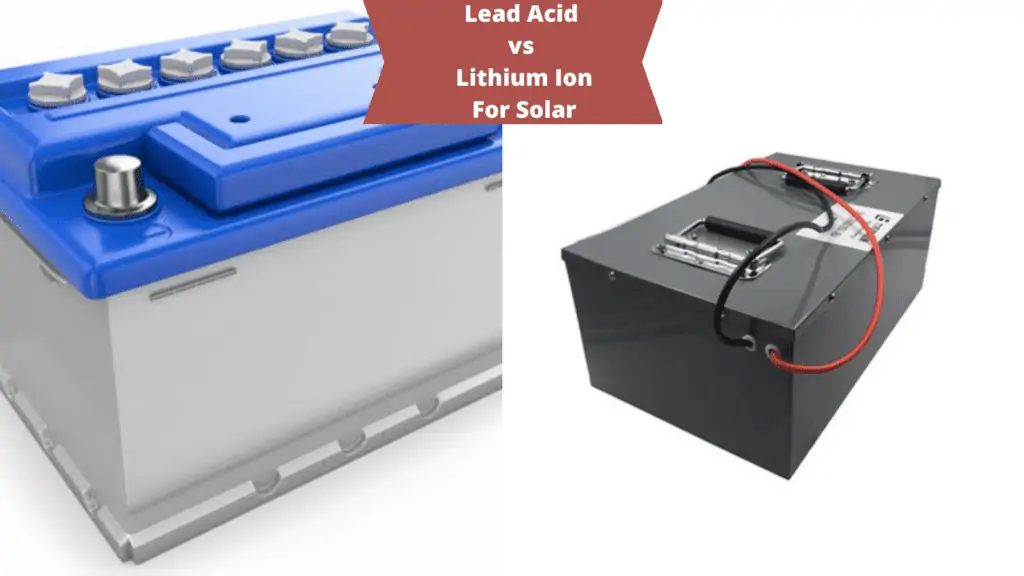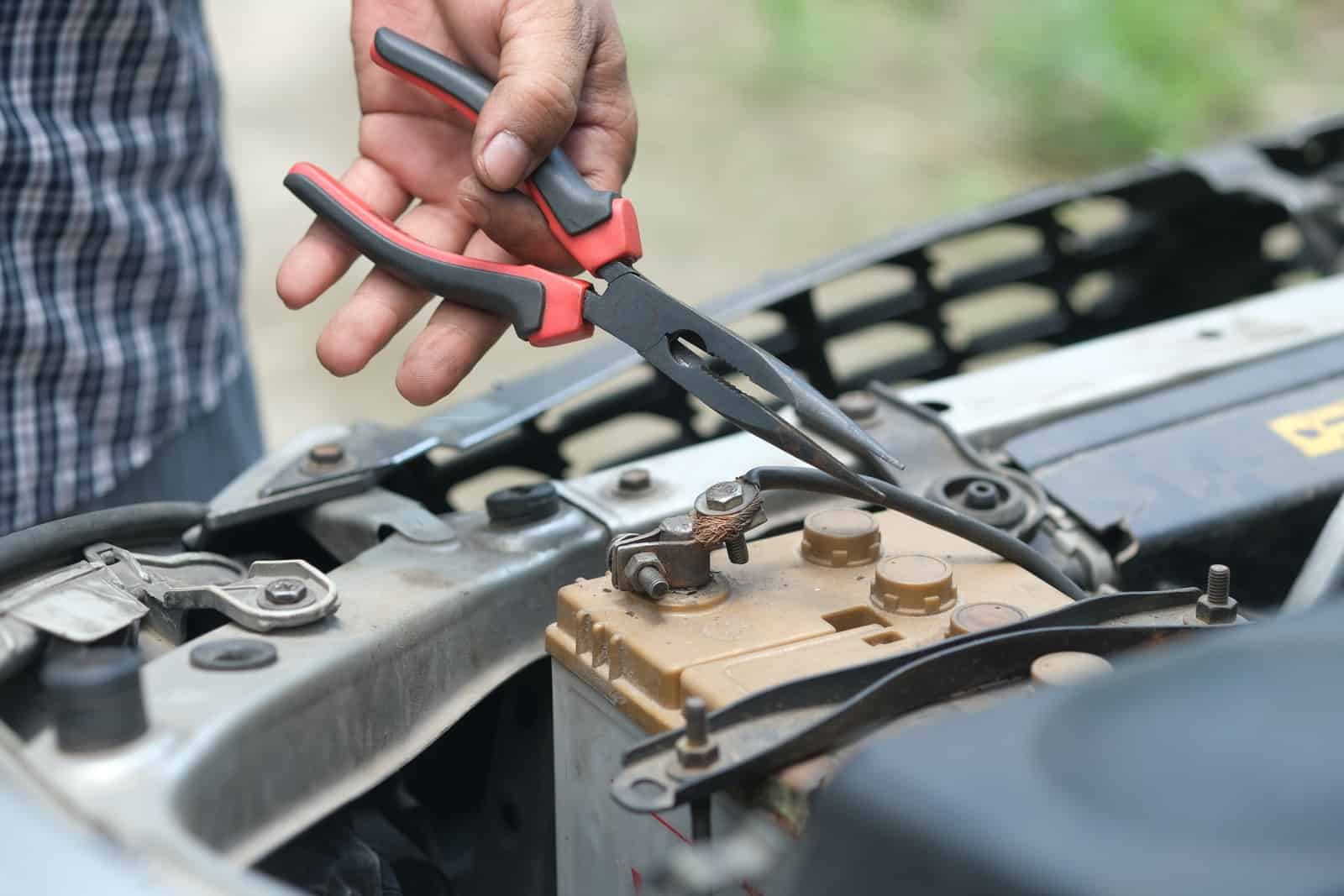If you want to know about lead acid vs lithium ion for solar, we will give you a run down. What’s the difference between lead acid and lithium ion batteries? The answer to this question depends on your needs.
We will discuss the differences between lead acid vs lithium ion batteries, including their overall cost and cycle life. Ultimately, you’ll want to choose one over the other based on your needs and budget.
Contents
80% Round-trip Efficiency
The difference between lithium-ion and lead-acid batteries is in the amount of energy they store. Lithium-ion batteries can store up to four times as much energy and still have usable energy. For example, the Surrette S-550 has a capacity of 1900 cycles at 50% DOD, while the Battle Born has a capacity of 6000 cycles at 50% DOD. A lithium-ion battery will have 3.2 times as much energy stored, and the cost per usable kWh of a lead-acid battery is only $0.64.
While both lead-acid and lithium-ion batteries offer many benefits, lithium-ion batteries are often the better choice for solar applications. Lithium-ion batteries are smaller than lead-acid batteries, but they are more efficient and last longer. They also have higher round-trip efficiency than lead-acid batteries, and their lifespans are longer. Lithium-ion solar batteries are also easier to install and maintain than lead-acid batteries.
The main advantage of lead-acid batteries is their lower cost per kWh stored and usable kWh per week. However, lead-acid batteries have highly specific DoD specifications, which make them a poor choice for solar power. In comparison, lithium-ion batteries offer near-100 percent DoD. The Tesla Powerwall offers an impressive 100% DoD.
In comparison to lead-acid batteries, lithium-ion batteries offer lower internal resistance and higher discharge rates. This makes lithium-ion solar cells safer for stationary use. Furthermore, they can be connected in series to create a battery bank with a higher voltage. Lithium-ion battery cells can also be used as a voltage regulator for the electricity network.
Although lead-acid batteries have been the standard in solar energy storage for over 100 years, newer technologies like lithium-ion are rapidly gaining popularity as a viable alternative to these older batteries. Both types of batteries offer benefits for solar energy storage. Whether you opt for a lithium-ion battery for your system, it’s essential to know which one will best suit your needs.
The main difference between lithium-ion and lead acid batteries is in the type of energy storage. Lithium-ion batteries are better than lead-acid, but are also more expensive than lead-acid batteries. However, lithium-ion batteries are less susceptible to overcharging. Lithium-ion batteries also offer better power density, so they can run a light fixture longer. Lithium-ion batteries are recommended when temperatures are between 32oF and 113oF.
Although lead-acid batteries are the more cost-effective option, they are still not suitable for most solar energy applications. This is primarily because lead-acid batteries are more durable, but lithium-ion batteries have the edge in energy return. A 5% difference in energy return is equivalent to thousands of kilowatt-hours of electricity. Lead-acid batteries need much less maintenance than lithium-ion batteries.
Longer Cycle Life
When comparing lead acid vs lithium ion batteries for solar systems, you’ll notice that the former has a higher life cycle, allowing you to use them for many more cycles than the latter. In addition, lithium batteries tend to have a longer cycle life because they require less maintenance. Lithium batteries also have more energy density, making them more suitable for storage applications.
But, while it’s true that lead acid batteries last longer, they have a much higher environmental impact. That’s because lead acid batteries require more raw materials for their manufacture, which means more mining and a larger environmental impact. Moreover, the lead acid battery industry is also energy-intensive, causing a significant amount of pollution in the process. For these reasons, it’s best to choose lithium-ion solar batteries for your solar array.
While lithium-ion batteries have the advantage of a higher weight, they are considerably less expensive than their lead-acid counterparts. Lithium batteries are also easier to install. Their smaller size makes them easy to transport and install. They’re also cheaper to purchase. The best solar battery for your home can be one of these, and their cost of ownership is also lower than that of lead-acid.
While both lead acid and lithium-ion batteries can offer long-term power, lithium-ion batteries are more durable. Lithium-ion batteries can last for over 10 years and even 10,000 cycles. Lithium-ion batteries have a much better balloon material than lead-acid batteries. They also last longer in harsh weather conditions. There are some differences, but it’s worth comparing them.
As mentioned earlier, lithium-ion batteries are more efficient. However, their discharge capacity is lower than lithium-ion batteries, and they can only handle 600 cycles at 80 percent capacity. This means that lithium-ion batteries are the better choice if you’re looking for solar storage. If you’re interested in the lifespan of solar energy batteries, lithium-ion is the best choice.
Another difference between lead-acid and lithium-ion batteries is that lithium batteries are lighter. Because of their lighter weight, they can be fitted into tighter spaces. If you want to use lead-acid batteries, you’ll need 8 of them. And lithium batteries are half the size. But they also weigh half as much as lead-acid batteries. Moreover, lithium battery banks are also less bulky than lead-acid batteries.
Both lead-acid and lithium-ion batteries have their disadvantages. The former is prone to heat when charging. Therefore, lithium-ion batteries will need a cooling period. However, they do last longer than lead-acid batteries. Thus, lithium-ion is still the better choice. But if you’re concerned about safety and maintenance, go for lead-acid.
Lead Acid Vs Lithium Ion For Solar Cost
While both lead acid and lithium-ion batteries are capable of storing a fair amount of energy, lithium-ion is more expensive than lead acid. The difference is most pronounced in the cost of lead-acid batteries. The lithium-ion batteries are more expensive, but they last much longer. The lead-acid battery has a capacity limit and is not as efficient as lithium-ion. Its high energy density is also a major drawback.
The cost of lithium-ion batteries is higher, but the cost per kWh of lithium-ion batteries is lower. They are cheaper overall because lithium is a renewable resource and lithium-ion batteries have a low carbon footprint. A lithium-ion solar battery will cost less than a lead-acid one for the same energy output. The lithium-ion battery also lasts longer, which means you will save on maintenance costs.
Lead-acid batteries are the most commonly used type. They’re most commonly used in the automotive industry, and were until recently the only type of battery most off-grid systems used. Although lead-acid is cheaper than lithium, it requires regular maintenance. If you can provide proper upkeep for it, lead-acid batteries are dependable. But if you don’t, you may shorten its lifespan, void its warranty, and risk damaging it. In addition, FLA batteries must be installed in a ventilated enclosure to prevent corrosion.
While lithium-ion solar batteries are more efficient and recyclable, lead-acid batteries are not recycled nearly as often. Lithium-ion batteries are relatively new and have a lower recycling rate. This is expected to change, however, as the industry develops and the technology gets more advanced. It’s not yet cheap to recycle lithium-ion batteries, but with improvements in technology, they may be competitive with lead-acid batteries.
While lithium-ion solar batteries are more efficient, they have higher up-front costs. In addition, lead acid solar batteries are much cheaper than lithium-ion solar battery systems. The price difference is not insignificant – lead-acid solar battery systems cost just a few hundred dollars less. In addition, lithium-ion solar batteries are more expensive but have a longer lifespan.
Another major difference between lead-acid and lithium-ion batteries is that lithium-ion has more energy density per weight. It also has a smaller form factor, which makes it easier to store and transport. Lead-acid batteries require large solar arrays to maintain. The lithium-ion solar battery is much lighter and can remain at half-charge for months at a time.
While both lead-acid and lithium-ion solar batteries have many advantages, lithium-ion is the better choice in terms of cost and performance. Lithium-ion batteries offer superior performance and reliability, while lead-acid batteries have much lower initial costs. The cost of lead-acid solar battery systems can be anywhere from $500 to $15,000, including installation. And while both lead-acid batteries are less expensive than lithium-ion, they are not as maintenance-free.
Final Thoughts On Lead Acid Vs Lithium Ion For Solar
Our conclusion on the lead acid vs lithium ion for solar discussion is a simple one. Lithium ion is a better choice battery for your solar system, with better options coming to the market each year. At the end of the day, it will boil down to your needs, budget and preference.


